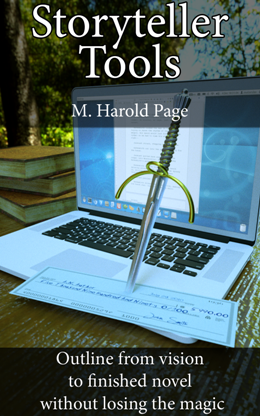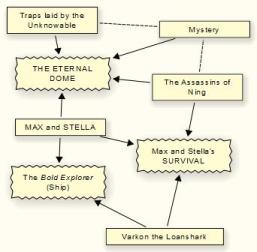NaNoWriMo is coming!

Like Winter, NaNoWriMo is coming and aspiring writers are even now planning to do a Frazetta on the whole business of writing a novel. This is great — momentum is all — but it’s way too easy to grind to a halt or lose time going round in circles trying to reinvent the wheel.
I wrote a book on all this, but some of my previous blog entries might also help you avoid dead ends and rampage through your novel to the very end — I promise you both an affirming and life changing experience.
So, here they are in digest form:
Some Writing Advice That’s Mostly Useless (And Why): The following writing advice is mostly useless — “Work on your motivation,” “Revise, revise, revise,” “Have a chaotic life,” “Just write,” “Know grammar and critical terms,” “Practice skills in isolation.”
World Building Historical Fiction using Military Thinking: Don’t fall down the rabbit hole of research or worldbuilding. Instead use a layered approach, focussing your world building as you descend from Strategic (villas exist and can be raided for supplies), through Operational (this villa sits on this ground amidst these fields), to Tactical (here is the ground plan of the villa and here are the people guarding it) level.
NaNoWriMo: How to “Pants” Through Your Novel like a Rampaging Panzer Division in 1940 France (and Why You Should): If you subscribe to the “Just Write” approach, then — seriously — just write. Switch off your spell checker, don’t edit or tinker, and if you need to add something to the story, just make a note and move on. You can mop up later.

Finding Your Groove in NaNoWriMo: The Rhythm of Writing: Probably the most useful piece of advice I can give you. Draft your prose in a kind of dialogue rhythm thus:
WORLD [Paragraph of external events seen from the character’s point-of-view and described using their voice.]
CHARACTER [Paragraph from the character’s point of view, beginning with visceral reactions , working through physical reactions and ending in speech or thought.]
Find the Conflict: Unblocking (or Actually Planning!) your NaNoWriMo Novel: Actually, planning is a good idea. You don’t have to over-plan, though, just identify the main conflicts — I have a nifty way of doing this using diagrams (see left). This should make it easier to keep things moving.
The Joy of Outlining: Seriously, outlining is great fun. It lets you throw tendrils of creativity into your novel’s possible future and then pick the one you want, creating and destroying whole worlds at the stroke of a pen.
How To Write a Good Fight Scene: Have a model of how the relevant martial art works, even if it’s invented. Have a clear tactical scenario that creates story-related dilemmas. Track consequences and continuity. Balance detail with summary. Keep combat nasty. See also Guy Windsor’s article.
Writerly New Year’s Resolutions and How to Make Them Work: Part 1 and Part 2: Applies to NaNoWriMo as well as New Year! Have clear objectives, learn your craft, create and defend writing space.
Good luck!
M Harold Page has several franchise novels in print. His book Storyteller Tools is all about how he did it. You can also download Swords Versus Tanks 1: Armoured heroes clash across the centuries! and Swords Versus Tanks 2: Vikings battle Zeppelins while forbidden desires spark! from Amazon.
Lovely round-up! The two times I did Nanowrimo, I did a bunch of index-card outlining beforehand. Well worth it.
It helped that I was writing in a familiar world where I’d done novel-length work before, with a main character I’d already developed in a short story.
Actually, the opening movement of that Nanowrimo novel is the project that spun itself off into “The Imlen Bastard,” the novella I’m launching with my Kickstarter campaign. After Nanowrimo ended, I polished the heck out of that thing.
I’m going to give it a shot. 2000 words a night sounds like a tall order but it is my understanding that this is the low norm for most writers.
I liked your conflict theory in your book too. It makes sense.
@Sarah—you might be the third writer that I know that got started through Nanowrimo. It must work or at least weed out the wannabees.
Theory? THEORY? PAH! Theory is for the literati! My focus on conflict is a technique, like a boogiewoogie bass-line is a technique.
Seriously, though, Wild Ape, glad you find it useful. 2K an evening is realistic, especially if you’ve done some planning.
Ape, my Nanowrimo meta-story is even weirder than that. When I tried Nano for the first time, I’d already written a 300,000 word first novel, and about 150,000 words of its sequel. I tried Nanowrimo in the hope that the experience would teach me to write shorter manuscripts, or maybe get me to complete a manuscript short enough that I could sell it to a big publisher.
I’m still writing at weird lengths. On the other hand, the novella I’m Kickstarting is one I love rereading, and I think its readers will really enjoy it.
Great stuff, MHP. I’m in the middle of revising a novel on under contract for, so not much chance I can participate this year, but I’ve passed along your post via Twitter.
(Dips sword in salute)
[…] Harold Page has a post up on the Black Gate website linking to a whole bunch of writing advice posts. This one, Find the Conflict: Unblocking (or […]